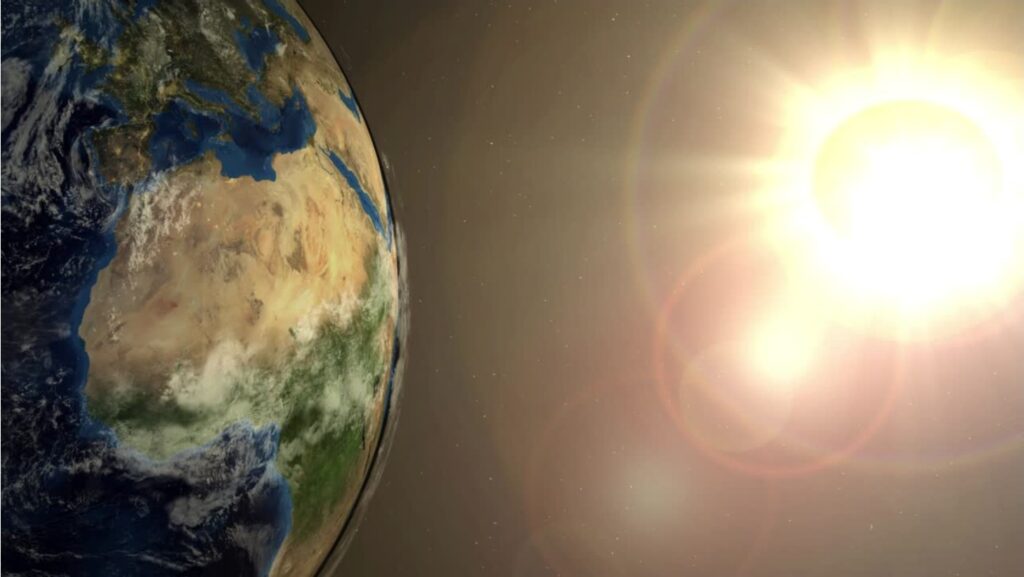HUSAM AHMED SHAFEEQ
We take Earth for granted with all its blessings that we fail to appreciate it for the marvel it truly is—a cosmic habitat exquisitely tuned for life.
The conditions that make life possible on Earth involve complexities on multiple dimensions that attributing it to chance defies reason. The improbably precise values of the universal constants, the fine-tuned properties of the fundamental particles, and countless other intricacies are necessary prerequisites for life to arise. Beyond that, a planet should also meet a separate set of other criteria—such as an optimal distance from its star, the presence of liquid water, a stable and suitable atmosphere, and a strong magnetic field, among various others—to be hospitable to life.
Even after accounting for all these complexities, we see that Earth, throughout its journey, faced many double-edged dilemmas, where the very factors essential for life also posed detrimental risks to it.
Here we explore a few of such paradoxes—each demonstrating how Earth had to evade an infinitude of alternative possibilities to emerge as the sole home to life we have known so far, against the blind backdrop of a mindless cosmos.
The goldilocks zone and the puzzle of water
One of the most basic and non-negotiable criteria for life, as we know it, is for a planet to be placed at an ideal distance from its host star, which would allow for the presence and maintenance of liquid water. That is, a planet should not be too close to its sun that water gets vaporised, nor too far that it becomes frozen. This narrow orbital range around a star is known as the habitable zone.[1]
We have always heard, and quite rightly so, that Earth is located precisely within this habitable zone of our Sun. What we may not have heard as much is that this perfect placement also comes with a paradoxical twist.

According to the nebular hypothesis, which is the most widely accepted explanation of how our solar system formed, a protoplanet must be beyond a specific distance from the star for water to find its way onto it. Inside this critical boundary, known as the frost line or the snow line, volatile elements like water would not condense into solid form to incorporate into the planetary materials.[2]
Ironically, the habitable zone of our solar system falls within this frost line.[3] This means that on the one hand, Earth is in the right location to maintain water’s liquidity, yet on the other, it is positioned outside the zone where water could be available in the first place. That is to say, Earth should exactly be where it is—and not there at the same time—for water to be present on its surface.
This seemingly irremediable situation—where the solution itself becomes the very problem it seeks to resolve—had to be overcome through processes that involved multiple phases of fine-tuning.
Many early theories suggested that water was condensed into ice beyond the frost line before being delivered to Earth by comets.[4] However, this explanation was later found to account for only 10 percent of Earth’s total water content.[5] Recent studies propose that Earth’s water can be traced back to meteorites that originated in the outer solar system but later moved to the inner region to become part of the nascent planet.[6] But this still begs the question as to how those volatiles could have existed in bound form so close to the Sun.
Anyhow, as scientists work to unravel the secrets behind this—and hopefully future research helps find a complete answer—each discovery invariably fuels our astonishment and leaves us in awe at the intricacies of how Earth managed to possess water in sufficient amount to sustain life.
Oxygen: A guarantor of life or an agent of death
We know oxygen as the elixir of life. It is an element so vital that nearly all complex organisms depend on it for survival. However, this magical gas, now hailed as the hero of life, had also played a villainous role in the past.
The origin of life from non-living matter was the result of a long sequence of intricately fine-tuned processes. Owing to its highly reactive nature, the presence of oxygen would have been a molecular menace to this fragile transformation.[7]
Thankfully, Earth was devoid of free oxygen molecules during that phase, which significantly favoured the emergence of life. Even after life originated—which was an impossible story in itself—the early life forms on Earth thrived in a world mostly or completely free of oxygen.[8] While this was in service of those anaerobic organisms to whom, oxygen was toxic, another greater problem was in the making.

Without an efficient energy source, life remained confined to the microbial world,[9] which in the absence of a protective atmospheric layer like ozone, was further restricted to sheltered regions—such as underwater and primordial ponds—to be safe from the Sun’s harmful ultraviolet radiation.[10] This confinement significantly limited the evolution of biological diversity, given which, it would not be unreasonable to assume that life was possibly at a potential risk of elimination, particularly on a planet that has witnessed many instances of mass extinctions.
Interestingly, both these problems could be efficiently resolved by a single element—oxygen. Being a powerful metabolic fuel, oxygen would adequately meet the high energy demand of complex biological functions. Likewise, since ozone (O3) is a triatomic form of oxygen, it would also serve as the most suitable component to form a protective barrier against ultraviolet rays from the Sun. Yet, on the other hand, oxygen was lethal to the early microbial organisms.
Thus, oxygen was both the way and in the way of life’s journey towards survival. In other words, life’s sustenance hinged on the very element that had the potential to annihilate it.
Here entered cyanobacteria, whose pioneering photosynthetic activity started producing what was essentially a poison to themselves but a life-saving panacea to future life forms. These microbial engineers flooded Earth with oxygen, murdering many of their contemporaries,[11] and also nearly endangering themselves—were it not for the timely protective mechanisms they were endowed with.[12]
In what can be described as an act of evolutionary altruism, for millions of years, cyanobacteria continued to release oxygen into Earth’s atmosphere, thus paving the way for the formation of the ozone layer and the emergence of diverse and complex life forms.
As we breathe in the molecules of life today beneath a radiation-filtering umbrella, let us not forget the seminal efforts of these microscopic heroes—to whom we remain eternally indebted for their selfless service.
Oxygen dilemma continues: Getting the perfect atmosphere
As cyanobacteria (and later other photosynthesising organisms) relentlessly carried out the most vital service in Earth’s history, they also introduced a danger that again threatened life itself.
Oxygen is the breath of life, but it is also the fuel of destruction. It is the energy source of complex life forms, but it is also the catalyst for combustion. Too little of it would render aerobic respiration difficult, or even impossible; and too much of it would trigger frequent fires even in damp forests, turning them into infernos.
This warrants the presence of oxygen in our atmosphere in a precise balance. Coincidentally (or perhaps not quite coincidentally) Earth holds its atmospheric oxygen at a perfect 21 percent, enabling biological respiration while also keeping combustion under control. This ideal amount was achieved through the complementary functioning of various intricate factors, including photosynthesis, respiration, decay, weathering, and volcanic release among various others, forming a complex and delicate equilibrium.[13]

However, despite this perfect balance, the rest of the atmosphere should also be composed of the right gases to regulate the effects of oxygen. Specifically, the atmosphere should be predominantly made up of a gas similar in density to oxygen so that the two mix well and not form layers.[14] Also, the companion gas should be less reactive to prevent undesired reactions with biological molecules, and non-greenhouse to maintain a perfect temperature.
In terms of availability and abundance in the solar system, there were many unfit candidates—such as carbon dioxide, methane and ammonia—that could have claimed this place. However, in that case, Earth would have veered off its delicately narrow course towards life and ended up sterile. But quite surprisingly, Earth managed to have nitrogen as the most dominant gas, accounting for around 78 percent of its atmosphere. Nitrogen perfectly meets the aforementioned criteria[15] and a long checklist of other delicate constraints, making it a key component of Earth’s life-sustaining atmosphere.
Accident or agency?
Long story short, life is a phenomenon that lies far beyond the reach of randomness. At every step, the extreme fragility of chance is challenged by the pitiless laws of improbability, rendering the accidental emergence of life logically impossible.
Throughout its journey, Earth had to gamble against an infinite array of possibilities, nearly all of which would have led to lifelessness. Yet, at every juncture, it managed to invariably choose the right path that led to life. If this sounds like intelligent design, that is because it is.
Yet ironically, some modern self-proclaimed custodians of rationality argue that these complex processes took place unguided, driven by nothing but the blind interplay of physical laws. It is indeed their prerogative to subscribe to such foolishness, but to persuade others in the name of reason to partake in their delusion is audaciously unjust.
END NOTES
[1] Habitable Zones around Main Sequence Stars, James F Kasting et al. (1993), Icarus
While this foundational model defines the classical habitable zone based on the potential for surface liquid water, newer studies suggest that certain planetary conditions—such as internal heating or dense atmospheres—might allow environments hospitable to life even beyond these traditional boundaries. Yet these remain largely theoretical and model-dependent and do not undermine the central role of liquid water in defining planetary habitability.
[2] On the Evolution of the Snow Line in Protoplanetary Discs, Rebecca G Martin & Mario Livio (2012), Monthly Notices of the Royal Astronomical Society
[3] Ibid
[4] Building Terrestrial Planets, A Morbidelli et al. (2012), The Annual Review of Earth and Planetary Sciences
[5] Ibid
[6] Early Accretion of Water in the Inner Solar System from a Carbonaceous Chondrite-Like Source, Adam R Sarafian et al. (2014), Science
[7] Natural Radioactivity and Chemical Evolution on the Early Earth: Prebiotic Chemistry and Oxygenation, Boris Ershov (2022), Molecules
[8] When Anaerobes Encounter Oxygen: Mechanisms of Oxygen Toxicity, Tolerance and Defence, Zheng Lu & James A Imlay (2021), Nature Reviews Microbiology
[9] Oxygen in the Evolution of Complex Life and the Price We Pay, Victor J Thannickal (2008), American Journal of Respiratory Cell and Molecular Biology
[10] Habitat of Early Life: Solar X-Ray and UV Radiation at Earth’s Surface 4-3.5 Billion Years Ago, Ingrid Cnossen et al. (2007), Journal of Geophysical Research
[11] The Strange History of Atmospheric Oxygen, John B West (2022), Physiological Reports
[12] Oxidative Stress in Cyanobacteria, Amel Latifi et al. (2009), FEMS Microbiology Reviews
[13] Atmospheric Oxygen Over Phanerozoic Time, Robert A Berner (1999), Proceedings of the National Academy of Sciences
[14] If a gas is significantly heavier than oxygen, it would tend to settle below, potentially reducing oxygen’s availability near the surface for respiration. Conversely, if a gas is much lighter, it may rise above and concentrate oxygen near the surface, which can enhance combustion risks due to higher oxygen concentration.
[15] Nitrogen (1.25 g/L) has a density very close to that of oxygen (1.43 g/L), allowing it to mix uniformly in the atmosphere. Additionally, nitrogen is largely inert under standard atmospheric conditions and does not contribute to the greenhouse effect, making it an ideal background gas in Earth’s atmosphere.













1 Comment
Naseer Ahmad CG · April 24, 2025 at 4:17 am
SubhaanaAllah.
Jazakallah for this wonderful writing. As I read the article, a verse from Holy Quran came to my mind and flowed from my lips.
“Our Lord, You did not create this aimlessly; exalted are You (above such a thing); then protect us from the punishment of the Fire.” 3:192